To reduce pension risk, many organizations offer eligible participants the opportunity to receive their pension benefit as a single lump sum and “cash out” their future benefit. This event is also called a “window.” The audience for a lump sum window varies and can include actives, terminated vested participants, retirees, and beneficiaries. During a lump sum window, an eligible vested participant can:
- Elect to receive an immediate lump sum payment
- Begin receiving (or change the form of) monthly annuity payments
- Defer benefit payments until a later date
The U.S. government requires participants to be provided enough information to make a decision in their best interest. If participants respond and take advantage of the limited opportunity, successful cash-outs can reduce fees and future plan liabilities. That’s where engaging communications enter the picture. Statistics show the more you educate, communicate, and simplify—the higher take-up rate you can expect from participants. Generally, Milliman has seen that programs with effective communication campaigns can achieve response rates in the range of 50% to 60%.
This article provides proven components of successful lump sum window campaigns that result in a win/win for you and your participants.
What information should lump sum window communications include?
Your main goal is to simplify the decision-making process. You also want to ensure that participants are not overwhelmed with their options. To accomplish these priorities, provide impartial communications that:
- Keep it simple. Clearly identify information. Then separate the facts from the action steps that need to be taken.
- List the action step first. Move the action step to the beginning of the education packet. This simple change helps drive participants to respond.
- Repeat. Highlight what participants need to know, what they need to do, and where they can find help along the way.
- Offer clear choices. Carefully present unbiased and understandable options. Describe forms of payment and the ability to choose a non-spouse beneficiary (if allowed in the plan).
- Present materials in an eye-catching design. Design, layout, company logo, graphics, and colors are all factors that can make the difference between a package that gets a response and one that is ignored.
Offer support. Participants will not respond if they have unanswered questions. Look for easy-to-use ways to allow participants to ask questions and get answers, such as:
- A toll-free call center
- A point of contact in human resources
- Outside financial advisors
Then provide these service teams with materials, such as frequently asked questions (FAQs), communication samples, and training, to prepare them to answer questions and support the initiative.
Your lump sum communication plan needs to support the U.S. Government Accountability Office (GAO) recommendations regarding the key types of information participants should receive to understand a lump sum offer.
Answer common questions. Effective communications should answer the following questions:
- What benefit payment options are available?
- How was the lump sum calculated?
- How does the value of the lump sum compare to the monthly annuity?
- What are the pros and cons of accepting the lump sum?
- What are the tax implications of taking the lump sum?
- What role does the Pension Benefit Guaranty Corporation (PBGC) play? What level of protection does the PBGC provide on each benefit option?
- How do you accept or reject the lump sum? What is the deadline?
- Who may participants contact for more information or assistance?
What communication elements should you include in a successful lump sum communication campaign?
The purpose of having a communication campaign is to simplify the message through multiple touchpoints. Don’t expect one mass mailing to do the job. Instead, announce the window, educate about the opportunity, and provide reminders about the deadline. Lastly, send postcards confirming receipt and acceptance of paperwork once participant elections are confirmed. Below is an outline of communication elements to keep the message front and center for participants.
Postcard series
Announcement postcard. Send this communication two to three weeks in advance of mailing the education election packet. The announcement postcard accomplishes two things:
- Informs participants that they will receive an important packet of information from the plan sponsor.
- Notifies the administrator about bad addresses.
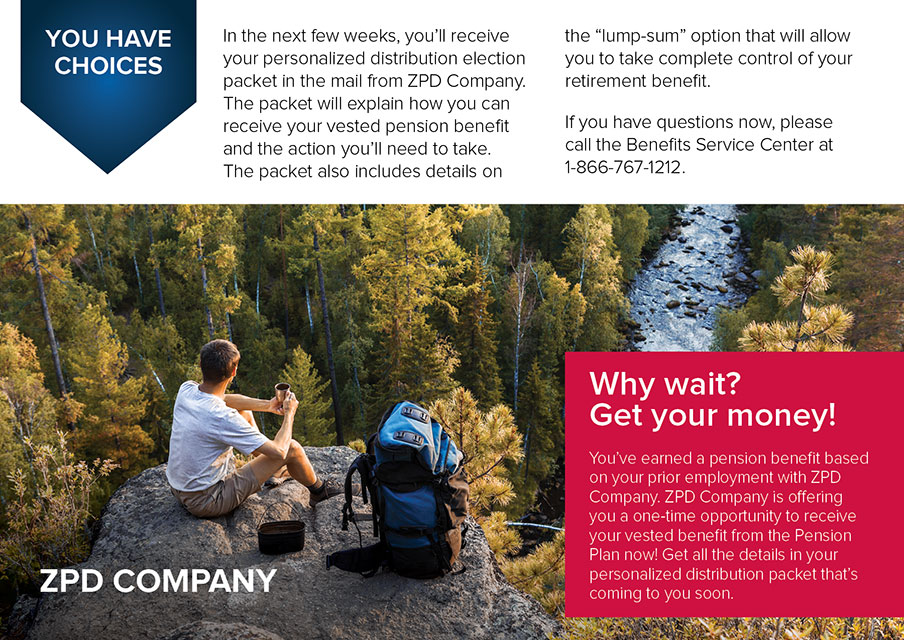 |
Announcement Postcard Sample Build awareness and alert participants of the upcoming opportunity. |
Reminder postcard. Send participants a reminder two weeks prior to the close of the window. Historically, take-up rates increase after sending this tickler.
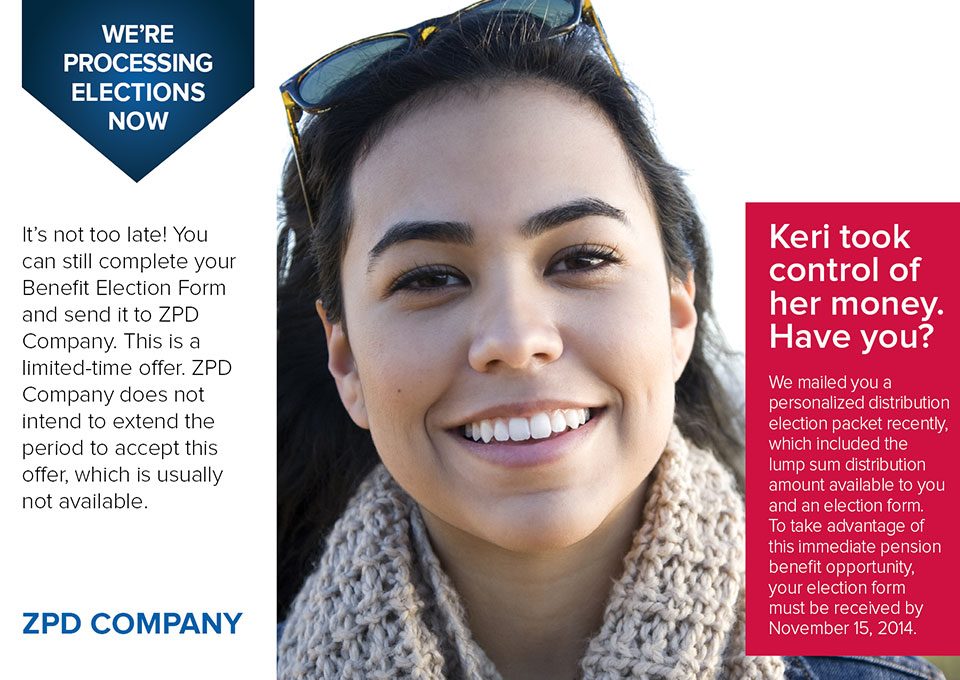 |
Reminder Postcard Sample Reminds participants about the one-time opportunity and deadline. |
Confirmation postcard. Put participants’ minds at ease by sending a postcard to confirm receipt and acceptance of their paperwork after elections are processed.
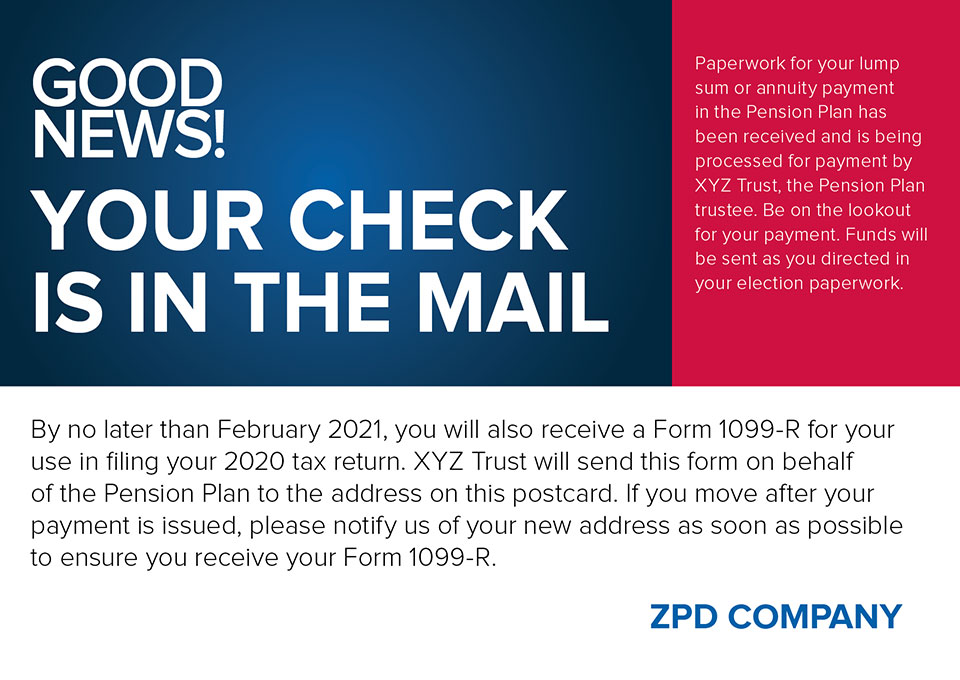 |
Confirmation Postcard Sample Informs participants that payments are on the way. |
Education election packet
Include in one packet everything a participant needs to know and do:
- Decision Guide with page dedicated to FAQs
- Personalized election form (a must)
- Prepaid business reply envelope to make it easy for participants to respond (optional but desired)
- 9” x 12” carrier envelope branded with client’s logo and including a tagline to draw attention to the contents: “Important Retirement Information Enclosed – Immediate Action Required”
Decision guide sample. Explains the lump sum versus annuity option and outlines considerations, including an example of how lump sum amounts can go up or down based on interest rates, rollover advantages, and FAQs.
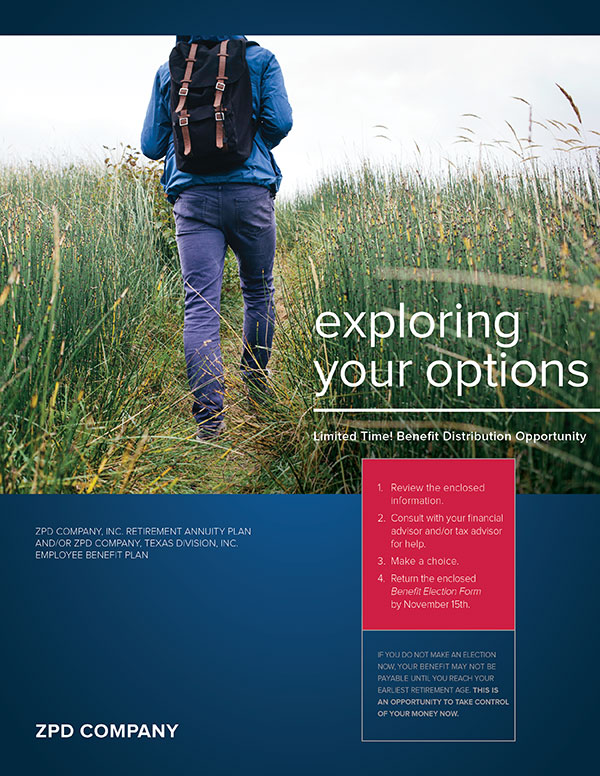 |
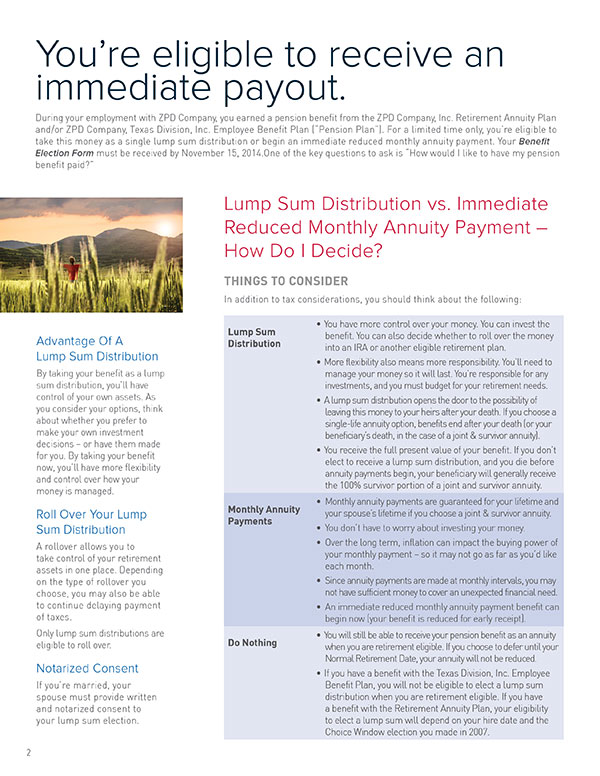 |
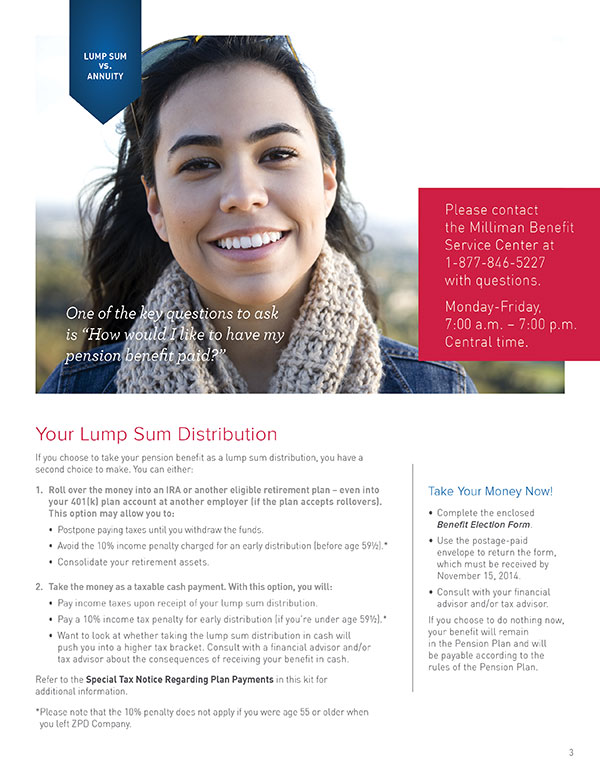 |
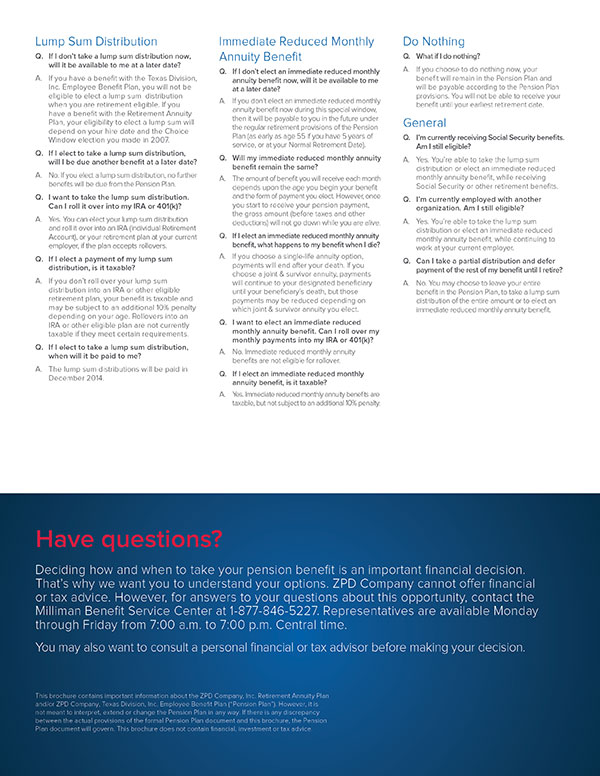 |
What extra steps can you take to boost the response rate?
Looking to increase the response rate? Go the extra mile; add these touchpoints:
- Offer recorded webinars with an overview of pension benefits, a discussion of lump sum versus annuities, and a look at other considerations.
- Offer live group meetings to walk through the statement, form, and election process.
- Include individual consultations with experienced retirement education specialists. This personal touch increases participant responses.
- Create letters for special situations, such as qualified domestic relations orders (QDROs), alternate payees, etc.
- Include an easy, one-step direct rollover option into the employer’s defined contribution plan for active employees, if applicable.
- Develop a website with personalized statements, online election capabilities, chat feature, and daily reporting of response rates.
- Consider offering direct deposit for lump sum payments.
- Ask the call center to reach out to participants who have not responded.
A successful lump sum window is supported by a thoughtful, well-planned and executed communication strategy. Get your communication consultant involved from the beginning so they can gather information early to develop messages to help participants feel confident about their benefit decisions.